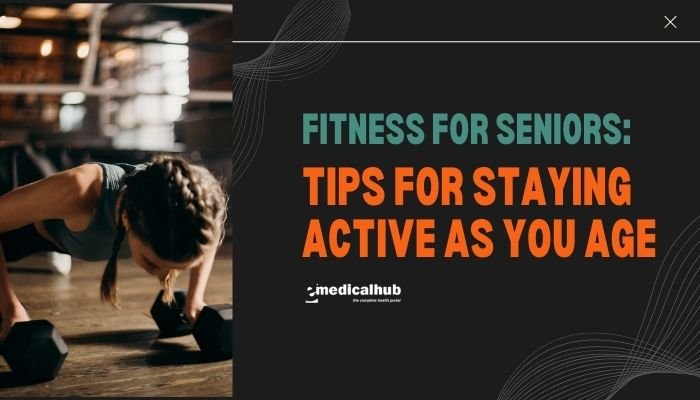Introduction
As we age, staying physically active becomes more than just a lifestyle choice—it’s essential for maintaining independence, preventing chronic disease, and enjoying a higher quality of life. For seniors, regular exercise can improve balance, increase muscle strength, enhance flexibility, and boost mental well-being.
Yet, many older adults face unique challenges such as joint pain, reduced stamina, or concerns about injury that may make starting or maintaining an exercise routine seem daunting.
This article explores the key benefits of fitness for seniors and provides practical tips to help older adults incorporate safe, effective, and enjoyable exercise into their daily lives. Whether you’re new to physical activity or looking for ways to diversify your routine, these guidelines can help you build strength, improve mobility, and support overall health.
Disclaimer: This content is intended for educational purposes only and does not replace personalized medical or fitness advice. If you have underlying health conditions or concerns, please consult a qualified healthcare provider before beginning any new exercise regimen.
Why Fitness Matters for Seniors
Physical Health Benefits
Regular exercise in older adults is associated with numerous benefits:
- Improved Cardiovascular Health: Increases heart rate, enhances circulation, and lowers blood pressure.
- Muscle Strength and Endurance: Helps combat sarcopenia (age-related muscle loss) and improves mobility.
- Enhanced Bone Density: Weight-bearing activities stimulate bone growth and reduce the risk of osteoporosis.
- Better Balance and Flexibility: Reduces fall risk and promotes safe, efficient movement.
- Weight Management: Helps maintain a healthy body weight and reduces the risk of obesity-related conditions.
- Chronic Disease Prevention: Reduces the risk of conditions such as type 2 diabetes, arthritis, and heart disease.
Mental and Cognitive Benefits
Fitness is not just about physical health—it also plays a crucial role in mental well-being:
- Mood Improvement: Physical activity triggers the release of endorphins, leading to reduced stress and improved mood.
- Enhanced Cognitive Function: Regular exercise supports memory, attention, and overall brain health.
- Increased Social Interaction: Group activities and classes foster social connections that combat isolation and loneliness.
- Better Sleep Quality: Regular movement can help regulate sleep patterns and promote restful sleep.
Functional Independence
For seniors, maintaining the ability to perform daily tasks is paramount:
- Everyday Strength: Improved muscle strength makes routine activities, such as carrying groceries or climbing stairs, easier.
- Balance and Coordination: Enhancing these abilities can reduce the risk of falls and associated injuries.
- Increased Energy: Regular physical activity leads to improved stamina, allowing seniors to engage more fully in hobbies and social activities.
Types of Exercises Beneficial for Seniors
A well-rounded fitness program for seniors should include cardiovascular (aerobic) exercise, strength training, flexibility work, and balance exercises. Each component plays a vital role in overall health and functionality.
Aerobic Exercise
Aerobic activities increase heart rate and improve cardiovascular health. Recommended forms include:
- Walking: One of the simplest and most accessible exercises.
- Swimming: Provides a full-body workout with minimal joint stress.
- Cycling: Either stationary or outdoor cycling enhances endurance.
- Dancing: Engaging and fun, improving both cardiovascular fitness and coordination.
Benefits of Aerobic Exercise:
- Improved heart and lung function
- Enhanced mood and energy levels
- Increased stamina for daily activities
Strength Training
Strength training is essential for preserving muscle mass and bone density. Effective exercises include:
- Bodyweight Exercises: Squats, push-ups (modified), lunges, and planks.
- Resistance Band Workouts: Easy to use and adaptable to various strength levels.
- Light Dumbbells: Incorporate bicep curls, shoulder presses, and triceps extensions.
- Weight Machines: If available, these can help guide proper form in a controlled setting.
Key Points for Strength Training:
- Frequency: Aim for 2–3 sessions per week.
- Progressive Overload: Gradually increase resistance or repetitions.
- Form and Technique: Focus on proper alignment to prevent injury.
Flexibility Exercises
Flexibility training helps maintain joint range of motion and reduce stiffness. Consider incorporating:
- Static Stretching: Hold stretches for 15–60 seconds (e.g., seated hamstring stretch).
- Dynamic Stretching: Involves controlled, active movements (e.g., leg swings).
- Yoga or Pilates: Enhance both flexibility and balance, with the added benefit of mindfulness.
Examples:
- Neck and shoulder stretches for reducing upper body tension.
- Hip flexor and calf stretches to improve lower-body mobility.
Balance Training
Improving balance is critical for preventing falls and maintaining independence. Effective balance exercises include:
- Standing on One Leg: Hold for 20-30 seconds on each leg.
- Heel-to-Toe Walk: Walk in a straight line, placing the heel of one foot directly in front of the toes of the other.
- Tai Chi: A gentle martial art known for its focus on slow, deliberate movements that enhance balance and coordination.
- Use of Stability Balls or Balance Boards: Introduce controlled instability to engage core and leg muscles.
Creating a Personalized Fitness Plan for Seniors
Assess Your Current Fitness Level
Before starting any new exercise routine:
- Consult Your Doctor: Particularly if you have chronic conditions or have been inactive.
- Self-Assessment: Track your daily activity or try simple tests (e.g., how long can you stand on one leg?) to gauge your baseline.
Set Realistic Goals
Define clear, achievable targets:
- Short-Term Goals: For example, increasing daily walking time or mastering a specific stretch.
- Long-Term Goals: Such as improving overall strength, reducing blood pressure, or enhancing mobility.
- SMART Goals: Specific, Measurable, Achievable, Relevant, and Time-bound goals help maintain motivation.
Designing Your Weekly Routine
A balanced weekly plan might include:
- 3 Days of Aerobic Activity: Brisk walking, swimming, or cycling.
- 2–3 Days of Strength Training: Focus on different muscle groups each session.
- Daily Flexibility and Balance Exercises: Incorporate at least 10–15 minutes of stretching and balance work.
- Active Rest Days: Include light activities like casual walking or gentle yoga to promote recovery.
Example Weekly Plan:
| Day | Activity | Duration |
| Monday | Brisk walk (aerobic) + 10-min stretching | 30–45 minutes |
| Tuesday | Strength training (upper and lower body) | 30 minutes |
| Wednesday | Swimming (aerobic) or Tai Chi (balance) | 30 minutes |
| Thursday | Strength training (bodyweight/resistance bands) | 30 minutes |
| Friday | Brisk walk or cycling (aerobic) | 30–45 minutes |
| Saturday | Yoga or Pilates (flexibility and balance) | 30 minutes |
| Sunday | Active rest (leisure walk, light stretching) | 20–30 minutes |
Adjusting for Individual Needs
Consider factors such as:
- Mobility Limitations: If joint pain is an issue, opt for low-impact activities like swimming or cycling.
- Fitness Experience: Beginners should start slowly and progress gradually, whereas experienced seniors might incorporate higher intensity or resistance.
- Personal Preferences: Choose activities you enjoy to increase the likelihood of long-term adherence.
Safety Tips for Senior Fitness
Proper Warm-Up and Cool-Down
- Warm-Up: Begin with 5–10 minutes of light activity (e.g., walking or gentle arm swings) to prepare your muscles.
- Cool-Down: Conclude with static stretches to reduce muscle soreness and improve flexibility.
Listen to Your Body
- Avoid Overexertion: Start at a comfortable pace and gradually increase intensity.
- Rest and Recovery: Ensure you have adequate rest days to allow your body to recover.
- Hydration: Drink water before, during, and after exercise to stay well-hydrated.
- Proper Footwear: Invest in supportive shoes to protect your feet and reduce the risk of falls.
Modify as Needed
- Adapt Exercises: Use chairs, resistance bands, or water aerobics if traditional exercises are too challenging.
- Seek Professional Guidance: A certified trainer experienced with seniors can help tailor a program that minimizes injury risk.
- Medical Check-Ups: Regular health screenings help monitor conditions that might affect your exercise regimen.
Environmental Considerations
- Safe Spaces: Choose well-lit, even surfaces for walking or exercise.
- Weather Adjustments: If outdoors, dress appropriately for the season and use sunscreen in sunny weather.
- Indoor Alternatives: On days with inclement weather, consider indoor exercises like yoga, tai chi, or simple bodyweight routines.
Complementary Lifestyle Practices
Nutrition
- Balanced Diet: A nutritious diet supports energy levels, muscle repair, and overall health. Incorporate lean proteins, whole grains, fruits, vegetables, and healthy fats.
- Calcium and Vitamin D: Essential for bone health, particularly important as you age. Dairy or fortified alternatives, leafy greens, and exposure to sunlight are beneficial.
- Hydration: Adequate fluid intake is crucial for overall bodily functions and recovery post-exercise.
Mental Health
- Social Interaction: Joining group exercise classes or walking clubs can enhance motivation and emotional well-being.
- Mindfulness and Stress Reduction: Practices such as meditation, deep breathing, or gentle yoga can complement physical exercise by reducing stress.
- Sleep: Aim for 7-9 hours of quality sleep per night to support recovery and overall health.
Regular Medical Check-Ups
- Monitoring Health Metrics: Regular screenings for blood pressure, cholesterol, and bone density help tailor your exercise regimen.
- Adjusting Routines: As your health status evolves, adapt your fitness routine accordingly.
Real-World Success Stories
Case Study: The Active Retiree
Mrs. Thompson, a 68-year-old retiree, began a moderate fitness program that combined daily walks, bi-weekly strength training with resistance bands, and a weekly yoga class. Over a year, she reported:
- A 20% improvement in balance tests.
- Increased energy levels and reduced joint pain.
- Enhanced mood and better sleep quality. Her routine not only helped her maintain independence but also improved her overall quality of life.
Case Study: Office Worker Turned Weekend Warrior
Mr. Johnson, a 55-year-old former desk-bound professional, decided to adopt a fitness routine after experiencing mild mobility issues. By incorporating brisk walking during lunch breaks, weekend hikes, and simple home-based strength exercises, he gradually increased his daily step count from 3,000 to over 8,000. Within six months, Mr. Johnson observed:
- Noticeable improvements in stamina and balance.
- A reduction in chronic lower back pain.
- Better management of his weight, shedding 10 pounds without drastic dieting. His gradual progress and consistency demonstrate how even modest changes can yield significant benefits over time.
Frequently Asked Questions (FAQ)
What types of exercise are safest for seniors?
Low-impact exercises like walking, swimming, and cycling are generally safe. Incorporating strength training with bodyweight exercises and resistance bands is also beneficial, provided proper form is maintained.
How can I avoid injuries while exercising?
Always warm up before workouts and cool down afterward. Listen to your body, start with low intensity, and gradually increase difficulty. Using proper equipment and seeking professional guidance when needed can also help.
Is it necessary to exercise every day?
While daily movement is encouraged, strength training should be performed 2-3 times per week with rest days in between. Cardiovascular activities can be done daily if they’re low-intensity, such as brisk walking.
How do I know if I’m making progress?
Monitor your improvements in strength, balance, endurance, and overall energy levels. Regular assessments, such as measuring waist circumference, tracking weight, or noting how daily activities become easier, can be good indicators of progress.
Can I combine different types of exercises?
Yes. A well-rounded fitness routine includes aerobic, strength, flexibility, and balance exercises. This approach ensures comprehensive benefits and reduces the risk of injury.
How important is nutrition in a fitness plan for seniors?
Nutrition is crucial. A balanced diet rich in protein, vitamins, and minerals supports muscle maintenance, bone health, and overall energy, enhancing the benefits of regular exercise.
What should I do if I experience joint pain during exercise?
Modify your routine by reducing intensity or switching to low-impact activities like swimming or cycling. Consult a healthcare provider if pain persists.
Are group exercises beneficial for seniors?
Yes. Group activities can provide motivation, accountability, and social engagement, all of which enhance mental and physical health.
How do I get started if I’ve never exercised regularly?
Begin slowly with gentle activities such as short walks or chair exercises. Gradually incorporate strength and balance work, and consider joining a beginner’s class or seeking advice from a fitness professional.
What role does flexibility play in preventing falls?
Flexibility improves range of motion and balance, which are critical for preventing falls. Daily stretching and yoga can help maintain flexibility and reduce the risk of injuries.
Can fitness improve mental health in seniors?
Absolutely. Regular physical activity is linked to improved mood, reduced anxiety and depression, and better cognitive function. Social interaction during group exercises further enhances mental well-being.
How can technology help track my progress?
Wearable devices, smartphone apps, and fitness trackers can help monitor steps, heart rate, and other activity metrics, providing useful feedback on your progress and encouraging consistency.
Conclusion
Staying active as you age is vital for preserving independence, preventing injury, and enhancing quality of life. Fitness for seniors isn’t about achieving extreme athletic performance—it’s about integrating regular, manageable physical activity that supports overall health. Whether it’s through gentle aerobic activities, strength training to combat muscle loss, or balance and flexibility exercises to prevent falls, a tailored fitness plan can help seniors thrive.
By setting realistic goals, listening to your body, and incorporating a variety of exercises, you can maintain strength, mobility, and mental clarity well into your later years. Complementing physical activity with proper nutrition, hydration, and social engagement further enriches the journey to a healthier, more active lifestyle. Remember, it’s never too late to start—small, consistent steps today can lead to a better quality of life tomorrow.
References
- Cruz-Jentoft AJ, Baeyens JP, Bauer JM, et al. Sarcopenia: European consensus on definition and diagnosis. Age Ageing. 2010;39(4):412-423.
- Fragala MS, Cadore EL, Dorgo S, et al. Resistance training for older adults: position statement from the National Strength and Conditioning Association. J Strength Cond Res. 2019;33(8):2019-2052.
- Peterson MD, Sen A, Gordon PM. Influence of resistance exercise on lean body mass in aging adults: a meta-analysis. Med Sci Sports Exerc. 2011;43(2):249-258.
- Taaffe DR, et al. Effects of a resistance exercise program on body composition and physical function in older adults. J Am Geriatr Soc. 2009;57(11):2187-2194.
- Middleton A, Fritz SL, Lusardi M. Walking speed: the functional vital sign. J Aging Phys Act. 2015;23(4):471-482.
- Beaudart C, et al. Health outcomes of sarcopenia: A systematic review and meta-analysis. PLoS One. 2017;12(1):e0169548.
- U.S. Department of Health and Human Services. Physical Activity Guidelines for Americans, 2nd edition. 2018.
- Nelson AG, Weitzenkamp DA, et al. Balance and fall prevention in older adults. J Geriatr Phys Ther. 2017;40(4):203-210.
- Marcus RL, et al. The role of physical activity in the maintenance of physical function among older adults. J Aging Phys Act. 2014;22(4):493-510.
- Bemben MG, Lamont HS. Creatine supplementation and exercise performance: Recent findings. Sports Med. 2005;35(2):107-125.
- Haskell WL, et al. Physical activity and public health: Updated recommendations for adults. Circulation. 2007;116(9):1081-1093.
- U.S. Department of Agriculture. Dietary Guidelines for Americans 2020-2025.





